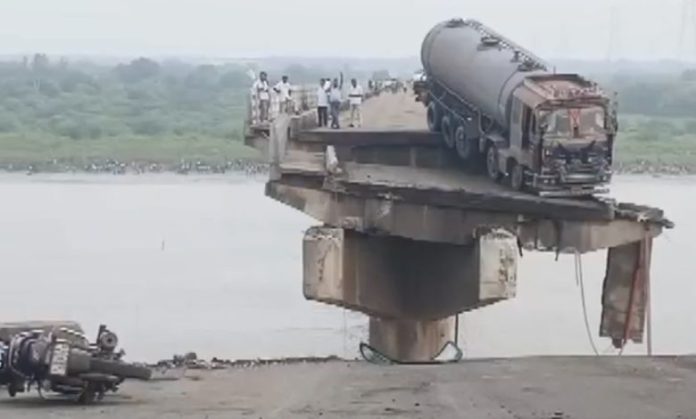– Mohd. Ziyaullah Khan, Nagpur
India’s infrastructure in 2025 tells a contradictory tale. On one hand, the government is investing trillions into highways, smart cities, hospitals, and airports. On the other, fatal bridge collapses, cave-ins, and service breakdowns are fuelling public outrage and distrust. The gap between ambition and execution has never been more visible. It’s a paradox in progress – while the government’s PR machinery paints a glossy picture of rapid development, the reality on the ground tells a very different story. Concrete results remain elusive, and what is flaunted as progress often appears superficial. In this article, we explore how the current infrastructure is crumbling, with no one held accountable.
Bridge Collapses and Road Failures: A Deadly Pattern
The Gambhira Bridge collapse in Gujarat on July 9, 2025, claimed nine lives. Just three weeks earlier, a similar tragedy occurred in Pune. These are not isolated incidents – monsoon-triggered infrastructure failures have become alarmingly routine across the country.
In Gwalior, a newly constructed ₹18 crore road collapsed within just 15 days of completion. Similar failures have been reported in cities like Noida, Chennai, and Chandigarh. These are not mere engineering glitches – they are manifestations of systemic issues: poor planning, rampant corruption, the use of substandard materials, lack of accountability, and weak regulatory oversight.
Despite this grim reality, the Prime Minister continues to make lofty claims, such as the use of space technology in modern road construction. However, these pronouncements appear hollow and misleading when viewed against the backdrop of collapsing bridges, pothole-ridden roads, and failing public infrastructure. The ground reality starkly contradicts the high-tech narrative.
Moreover, there seems to be little to no transparency in tender processes, limited third-party audits, and a disturbing pattern of contractors repeatedly evading consequences despite shoddy work. What we are witnessing is not just a failure of infrastructure, but a collapse of governance and public trust. Without structural reforms, increased accountability, and citizen-led vigilance, India’s ambitious infrastructure dreams may continue to crumble – both literally and figuratively.
Urban Chaos: Gurugram’s Rain Fury Exposes Planning Failures
On the same day as the Vadodara tragedy, Gurugram saw citywide paralysis after 133 mm of rain. Key roads were submerged, and authorities had to issue work-from-home advisories to prevent further chaos.
This is not an anomaly – it’s a reflection of flawed urbanisation, frequent layout revisions, poor road maintenance, and drainage failures. A 2023 government report warned that 431 large projects were delayed, with cost overruns of ₹4.82 lakh crore – largely due to poor planning and execution gaps.
Healthcare and Education: Foundations Still Fragile
India’s public services are grappling with severe infrastructure shortfalls:
- Healthcare: Only 26% of doctors serve rural areas, where 72% of the population lives. Urban hospitals remain overcrowded and under-equipped.
Though schemes like PM Ayushman Bharat Health Infrastructure Mission (PM-ABHIM) aim to boost capacity, public health spending is still below 2% of GDP.
- Education: Out of 14.7 lakh schools, 1.52 lakh lack electricity, thousands have no libraries, and many have no buildings. The UDISE+ 2023–24 report highlighted over 6,000 schools without a permanent structure, worsening the urban-rural education divide.
Telecom Breakdown: A Network of Gaps
Despite having over 1.16 billion mobile subscribers, India’s telecom sector suffers from frequent blackouts and patchy rural access. A Reliance Jio outage on June 16 left thousands without service.
- Underlying issues include:
- Limited spectrum (less than half of China’s or Europe’s),
- Debt-ridden telecom operators (₹4 lakh crore+), and
- Unviable rural expansion
The Telecommunications Act 2023 aims to simplify Right of Way (RoW) rules, but implementation remains slow and fragmented.
Highway Expansion: Fast Pace, Flawed Execution
India aims to complete a 2 lakh-km highway network by 2025, with record construction levels. Yet, complaints about poor build quality are frequent. Even Union Minister Nitin Gadkari recently flagged subpar construction and weak project planning.
Bridge collapses – 15 in Bihar alone in one year – show the cracks go beyond concrete. It’s not just about funding; execution, oversight, and maintenance remain critical gaps.
The Numbers Are There – But So Are the Cracks
The National Infrastructure Pipeline has earmarked $1.4 trillion for investment. The Union Budget 2025-26 allocated ₹11.21 lakh crore (3.1% of GDP) to capital expenditure.
Despite robust FDI and private sector involvement – like Adani Group’s ₹30,237 crore investment in Kerala – delivery lags persist. Even flagship initiatives like PM Gati Shakti and the National Logistics Policy are hampered by local corruption and lack of coordination.
Public Perception: Anger, Distrust, and Online Backlash
Social media platforms like X are buzzing with criticism:
- @shaandelhite highlighted frequent collapses in BJP-ruled states
- @Kings_Gambit__ blamed rampant corruption for post-inauguration failures
A viral post by @SolidBoosters (1.5 lakh+ views) underscored public frustration. Infrastructure is no longer just a development issue – it’s a political flashpoint.
Solutions: What Needs to Change – And Fast
Experts recommend a multi-pronged approach:
- Digital tracking and accountability via PM Gati Shakti’s GIS-based platform,
- Capacity building for engineers, contractors, and government officers,
- Independent third-party audits and public monitoring of infrastructure projects, and
- Uniform standards across states for design, construction, and maintenance.
Think tanks like ForumIAS are advocating a programme management approach to oversee the entire project lifecycle – from planning to maintenance.
The Make-or-Break Moment
India’s infrastructure journey is at a crossroads. Bold investments and fast-paced construction cannot substitute for transparency, quality, and accountability. Unless the system shifts focus from how much is spent to how well it is spent, India risks building a future on shaky foundations. The dream of becoming a $5 trillion economy will remain distant if the present continues to be plagued by collapsing bridges and crumbling classrooms.
[Mohd Ziyauallah Khan is a freelance content writer and editor based in Nagpur. He is also an activist and social entrepreneur, co-founder of the group TruthScape, a team of digital activists fighting disinformation on social media.]




